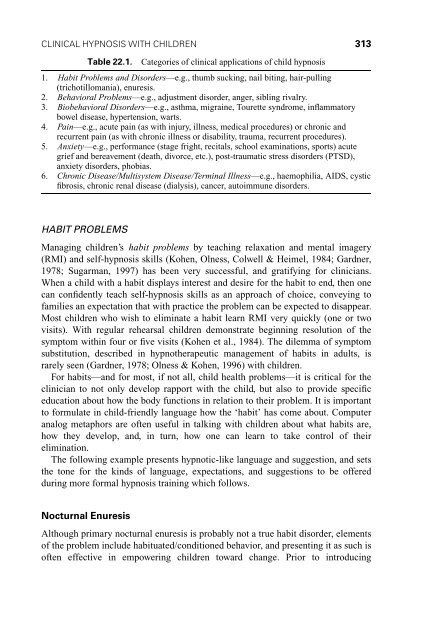International Handbook of Clinical Hypnosis - E-Lib FK UWKS
International Handbook of Clinical Hypnosis - E-Lib FK UWKS
International Handbook of Clinical Hypnosis - E-Lib FK UWKS
You also want an ePaper? Increase the reach of your titles
YUMPU automatically turns print PDFs into web optimized ePapers that Google loves.
CLINICAL HYPNOSIS WITH CHILDREN 313<br />
Table22.1. Categories <strong>of</strong> clinical applications <strong>of</strong> child hypnosis<br />
1. Habit Problems and DisordersÐe.g., thumb sucking, nail biting, hair-pulling<br />
trichotillomania), enuresis.<br />
2. Behavioral ProblemsÐe.g., adjustment disorder, anger, sibling rivalry.<br />
3. Biobehavioral DisordersÐe.g., asthma, migraine, Tourette syndrome, in¯ammatory<br />
bowel disease, hypertension, warts.<br />
4. PainÐe.g., acute pain as with injury, illness, medical procedures) or chronic and<br />
recurrent pain as with chronic illness or disability, trauma, recurrent procedures).<br />
5. AnxietyÐe.g., performance stage fright, recitals, school examinations, sports) acute<br />
grief and bereavement death, divorce, etc.), post-traumatic stress disorders PTSD),<br />
anxiety disorders, phobias.<br />
6. Chronic Disease/Multisystem Disease/Terminal IllnessÐe.g., haemophilia, AIDS, cystic<br />
®brosis, chronic renal disease dialysis), cancer, autoimmune disorders.<br />
HABIT PROBLEMS<br />
Managing children's habit problems by teaching relaxation and mental imagery<br />
RMI) and self-hypnosis skills Kohen, Olness, Colwell & Heimel, 1984; Gardner,<br />
1978; Sugarman, 1997) has been very successful, and gratifying for clinicians.<br />
When a child with a habit displays interest and desire for the habit to end, then one<br />
can con®dently teach self-hypnosis skills as an approach <strong>of</strong> choice, conveying to<br />
families an expectation that with practice the problem can be expected to disappear.<br />
Most children who wish to eliminate a habit learn RMI very quickly one or two<br />
visits). With regular rehearsal children demonstrate beginning resolution <strong>of</strong> the<br />
symptom within four or ®ve visits Kohen et al., 1984). The dilemma <strong>of</strong> symptom<br />
substitution, described in hypnotherapeutic management <strong>of</strong> habits in adults, is<br />
rarely seen Gardner, 1978; Olness & Kohen, 1996) with children.<br />
For habitsÐand for most, if not all, child health problemsÐit is critical for the<br />
clinician to not only develop rapport with the child, but also to provide speci®c<br />
education about how the body functions in relation to their problem. It is important<br />
to formulate in child-friendly language how the `habit' has come about. Computer<br />
analog metaphors are <strong>of</strong>ten useful in talking with children about what habits are,<br />
how they develop, and, in turn, how one can learn to take control <strong>of</strong> their<br />
elimination.<br />
The following example presents hypnotic-like language and suggestion, and sets<br />
the tone for the kinds <strong>of</strong> language, expectations, and suggestions to be <strong>of</strong>fered<br />
during more formal hypnosis training which follows.<br />
Nocturnal Enuresis<br />
Although primary nocturnal enuresis is probably not a true habit disorder, elements<br />
<strong>of</strong> the problem include habituated/conditioned behavior, and presenting it as such is<br />
<strong>of</strong>ten effective in empowering children toward change. Prior to introducing











![SISTEM SENSORY [Compatibility Mode].pdf](https://img.yumpu.com/20667975/1/190x245/sistem-sensory-compatibility-modepdf.jpg?quality=85)





